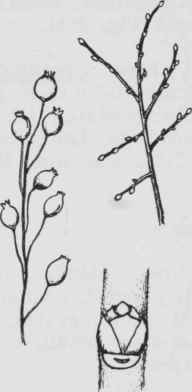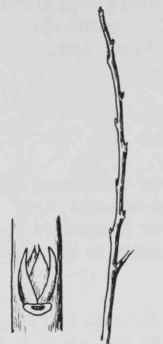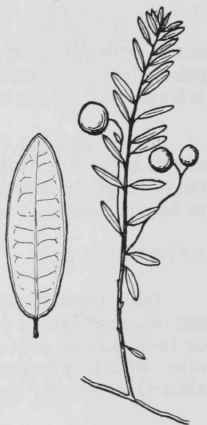Vaccinium L. (Ericaceae)
Description
This section is from the book "Woody Plants In Winter", by Earl L. Core, Nelle P. Ammons. Also available from Amazon: Woody Plants in Winter.
Vaccinium L. (Ericaceae)
Deciduous shrubs, usually under 1 m. tall, Sometimes trailing or arborescent (some species evergreen). Twigs slender, more or less angled; pith small, continuous. Buds small, solitary, sessile, with 2 or more scales; terminal bud deciduous. Leaf-scars alternate, small, half-round; bundle-trace 1; stipule scars none,

Fig. 267. Vaccinium stamineum.

Fig. 268. Vaccinium myrtilloides.
a. | Leaves deciduous | ||
b. Buds oblong, appressed, with 2 obtuse exposed scales | 6. | V. erythrocarpum | |
b. Buds ovoid or globose; scales several or pointed |

Fig. 269. Vaccinium vacillans.

Fig. 270. Vaccinium angustifolium.

Fig. 271. Vaccinium corymbosum.

Fig. 272. Vaccinium erythrocarpum.

Fig. 273. Vaccinium oxycoccos.

Fig. 274. Vaccinium macrocarpon.
c. Buds ovoid or oblong, ascending or appressed | |||
d. Low shrubs, 0. 5-9 dm. high | |||
e. Twigs nearly terete, very hairy | 2. | V. myrtilloides | |
e. Twigs grooved above the buds or angular | |||
f. Twigs smooth | 4. | V. angustifolium | |
f. Twigs granular-warty | 3. | V. vacillans | |
d. Taller shrubs, up to 4 m. high | 5. | V. corymbosum | |
c. Buds subglobose or ovoid, divergent | 1. | V. stamineum | |
a. | Leaves evergreen; stems trailing | ||
b. Leaves very small, 4-10 mm. long ,revolute | 7. | V. oxycoccos | |
b. Leaves larger, 6-18 mm. long, not re volute | 8. | V. macrocarpon |
1. V. stamineum L. Deerberry. Buckberry. Squaw Huckleberry. A diffusely branched shrub 3-9 dm. high, with pubescent twigs; buds subglobose. Dry thickets, Florida to Louisiana, north to Massachusetts, Ontario, and Missouri (Fig. 267).
2. V. myrtilloides Michx. Canada Blueberry. (V. canadense Kalm). A low shrub 2-6 dm. high; twigs nearly terete, very hairy; buds ovoid or oblong, scales several. Moist soil, Newfoundland and Quebec to British Columbia, south to Virginia, Ohio, Iowa, Saskatchewan and Montana (Fig. 268).
3. V. vacillans Torr. Late Low Blueberry. Low shrub, 3-9 dm. high; twigs glabrous, yellowish-green, distinctly warty, angled; buds ovoid or oblong. Dry soil, Georgia to Missouri,north to Nova Scotia, Ohio, and Iowa(Fig. 269).
4. V. angustifolium Ait. Low Sweet Blueberry. Early Low Blueberry. A low shrub to 2 dm. high; twigs smooth. Open barrens, Labrador and Quebec to Minnesota, south to Iowa, Illinois, and West Virginia (Fig. 270).
5. V. corymbosum L. Highbush Blueberry. Shrub up to 4 m. high, forming compact or open clumps; twigs angled and warty; buds ovoid or oblong. Swamps, Nova Scotia to Quebec, and Wisconsin, south to Florida and Louisiana (Fig. 271 ).
6. V. erythrocarpum Michx. Southern Mountain Cranberry. Shrub 3-18 dm. high, deciduous; twigs slender, pubescent, conspicuously angled; buds oblong,appressed, 1-1.5 mm. long. Thickets, in the mountains from Georgia to West Virginia (Fig. 272).
7. V. oxycoccos L. Small Cranberry. Stems trailing, very slender, branches almost capillary; leaves evergreen, 4-10 mm. long, 1-3 mm. broad, strongly revolute, conspicuously whitened beneath; berries present in winter, 6-8 mm. across. Bogs, Greenland to Alaska, south to North Carolina (in the mountains), Ohio, Wisconsin, Minnesota, Saskatchewan, Alberta, and Oregon; also in Eurasia (Fig. 273).
8. V. macrocarpon Ait. Large Cranberry. Stems comparatively thick, elongated; leaves evergreen, 6-18 mm. long, 2-8 mm. broad, pale beneath, flat or slightly revolute; berries present through the winter, 1-2 cm. across. Bogs, Newfoundland to Minnesota, south to North Carolina and Illinois (Fig. 274).
Continue to:


